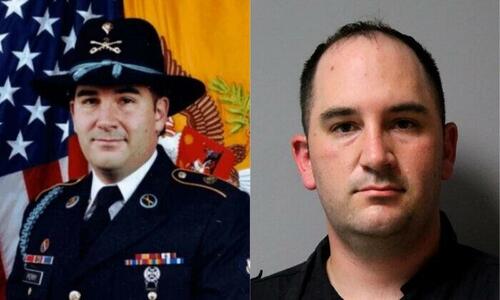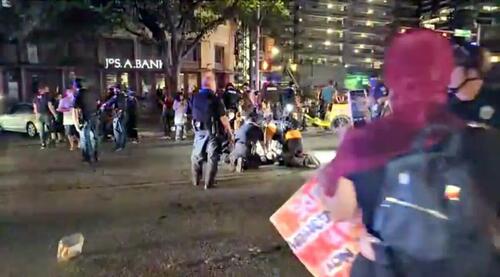
Authored by Tom Ozimek via The Epoch Times (emphasis ours),
Texas Gov. Greg Abbott has pardoned former U.S. Army Sgt. Daniel Perry, who was convicted of murder and sentenced to 25 years in prison for shooting an armed Black Lives Matter (BLM) protester who wielded an AK-47.

Mr. Abbott issued a proclamation on May 16 indicating that Mr. Perry has been granted a full pardon and restoration of full civil rights of citizenship, while taking aim at Travis County District Attorney Jose Garza for allegedly directing the lead investigator to withhold exculpatory evidence and demonstrating “unethical and biased misuse” of his office in prosecuting Mr. Perry.
“Texas has one of the strongest ‘Stand Your Ground’ laws of self-defense that cannot be nullified by a jury or a progressive District Attorney,” Mr. Abbott said in a statement announcing the pardon. “I thank the Board for its thorough investigation, and I approve their pardon recommendation.”
Earlier in the day, the Texas Board of Pardons and Paroles issued a pardon recommendation to the governor’s office, indicating in a statement that it had “delved into the intricacies” of Mr. Perry’s case, including reviewing police reports, court records, witness statements, and interviews with people linked to the case.
“The Board voted unanimously to recommend a full pardon and restoration of firearm rights,” the board said in the statement.
Mr. Garza’s office told The Epoch Times in an emailed statement that board’s decision and the governor’s pardon amount to a “mockery of our legal system.”
“Their actions are contrary to the law and demonstrate that there are two classes of people in this state where some lives matter and some lives do not,” he said.
More Details
Mr. Perry was convicted on April 7, 2023, on murder charges for killing Garrett Foster on July 25, 2020, during a BLM protest in Austin, Texas.
On the night of the shooting, Mr. Perry was working as a ride-share driver and had turned onto a street where Mr. Foster and dozens of other protesters were marching. After Mr. Foster approached Mr. Perry’s car carrying an AK-47 rifle and began to raise the rifle toward Mr. Perry, the former Army sergeant shot Mr. Foster, his attorneys said in his defense.
Mr. Perry claimed self-defense, but prosecutors claimed he had maliciously driven into a crowd of protesters and that Mr. Foster had the right to approach him and investigate.
Doug O'Connell, Mr. Perry’s attorney, said in a statement posted on social media that his client is grateful for the pardon and wishes “this tragic event never happened and wishes he never had to defend himself against Mr. Foster’s unlawful actions.”
“He is thrilled and elated to be free,” Mr. O'Connell wrote, while criticizing the “courtroom travesty” that put him behind bars for what would have been over two decades.
Mr. Perry served 372 days of his sentence before being freed, Mr. O'Connell said, while blaming Mr. Garza for tampering with witnesses during the case.
Mr. Garza told The Epoch Times that the pardon sends a message to those Travis County community members who served on the grand jury that their service is meaningless.
“To the family and friends of Garrett Foster, and to the people of Travis County, we will not stop fighting for justice,” Mr. Garza said.
Background
Mr. Perry, who was working as an Uber driver at the time of the shooting, traveled to Austin in July 2020 for work, according to a statement he provided through his attorneys.
After dropping a client off, Mr. Perry drove his vehicle onto Congress Avenue and encountered the protest, which was blocking the road. His attorney said that Mr. Perry was unaware of the demonstration before encountering the group.
“When Sgt. Perry turned on the Congress Avenue, several people started beating on his vehicle,” the statement said. “An individual carrying an assault rifle, now known to be Garrett Foster, quickly approached the car and then motioned with the assault rifle for Mr. Perry to lower his window.”
Mr. Perry complied with the request, initially believing that Mr. Foster was with law enforcement.
“It has now been confirmed by several witnesses that this individual with the assault rifle then began to raise the assault rifle toward Sgt. Perry,” his lawyer said in the statement. “It was only then that Sgt. Perry, who carried a handgun in his car for his own protection while driving strangers in the ride share program, fired on the person to protect his own life.”
After Mr. Perry shot Mr. Foster, another person in the crowd began firing on Mr. Perry’s vehicle, prompting him to speed away and, after reaching a safe location, to call the police.
Austin Police Chief Brian Manley told reporters after the shooting that people on the scene gave conflicting accounts of what happened, though he acknowledged that Mr. Foster may have pointed his gun at Mr. Perry.

Prosecutors alleged that Mr. Perry had provoked the shooting by driving into the crowd of protesters.
His attorneys argued that prosecutors withheld key evidence from the jury that suggested Mr. Foster was the aggressor. For instance, his attorneys sought to introduce evidence of three incidents that they said showed Mr. Foster had previously tried to intimidate cars on public streets.
Mr. Perry’s lawyers also repeatedly tried to introduce into evidence a video recording of Mr. Foster, taken by a protester witness on the morning of July 25, 2020. The video showed that when Mr. Foster was asked if he felt like he'd need to use his AK-47, he said: “Na. I think the uh—I mean if I use it against the cops, I’m dead. I think all the people that hate us, and you know, wanna say [expletive] to us are too big of a [expletive] to stop and actually do anything about it.”
According to Mr. Perry’s attorneys, the evidence showed that Mr. Foster and fellow protesters “routinely harassed vehicles that attempted to interfere with their efforts to ’take the streets.'”
Texas law indicates that a person is justified in using force against someone when they “reasonably” believe it’s necessary to protect them against another’s use of unlawful force.
The Board of Pardons and Paroles said in its May 16 statement that, after a “thorough review of the amassed information,” it concluded that Mr. Perry had acted lawfully and recommended he be pardoned.
Mimi Nguyen-Ly and Zachary Stieber contributed to this report. This article has been updated with comments from Mr. Garza’s office.
Authored by Tom Ozimek via The Epoch Times (emphasis ours),
Texas Gov. Greg Abbott has pardoned former U.S. Army Sgt. Daniel Perry, who was convicted of murder and sentenced to 25 years in prison for shooting an armed Black Lives Matter (BLM) protester who wielded an AK-47.

Mr. Abbott issued a proclamation on May 16 indicating that Mr. Perry has been granted a full pardon and restoration of full civil rights of citizenship, while taking aim at Travis County District Attorney Jose Garza for allegedly directing the lead investigator to withhold exculpatory evidence and demonstrating “unethical and biased misuse” of his office in prosecuting Mr. Perry.
“Texas has one of the strongest ‘Stand Your Ground’ laws of self-defense that cannot be nullified by a jury or a progressive District Attorney,” Mr. Abbott said in a statement announcing the pardon. “I thank the Board for its thorough investigation, and I approve their pardon recommendation.”
Earlier in the day, the Texas Board of Pardons and Paroles issued a pardon recommendation to the governor’s office, indicating in a statement that it had “delved into the intricacies” of Mr. Perry’s case, including reviewing police reports, court records, witness statements, and interviews with people linked to the case.
“The Board voted unanimously to recommend a full pardon and restoration of firearm rights,” the board said in the statement.
Mr. Garza’s office told The Epoch Times in an emailed statement that board’s decision and the governor’s pardon amount to a “mockery of our legal system.”
“Their actions are contrary to the law and demonstrate that there are two classes of people in this state where some lives matter and some lives do not,” he said.
More Details
Mr. Perry was convicted on April 7, 2023, on murder charges for killing Garrett Foster on July 25, 2020, during a BLM protest in Austin, Texas.
On the night of the shooting, Mr. Perry was working as a ride-share driver and had turned onto a street where Mr. Foster and dozens of other protesters were marching. After Mr. Foster approached Mr. Perry’s car carrying an AK-47 rifle and began to raise the rifle toward Mr. Perry, the former Army sergeant shot Mr. Foster, his attorneys said in his defense.
Mr. Perry claimed self-defense, but prosecutors claimed he had maliciously driven into a crowd of protesters and that Mr. Foster had the right to approach him and investigate.
Doug O’Connell, Mr. Perry’s attorney, said in a statement posted on social media that his client is grateful for the pardon and wishes “this tragic event never happened and wishes he never had to defend himself against Mr. Foster’s unlawful actions.”
“He is thrilled and elated to be free,” Mr. O’Connell wrote, while criticizing the “courtroom travesty” that put him behind bars for what would have been over two decades.
Mr. Perry served 372 days of his sentence before being freed, Mr. O’Connell said, while blaming Mr. Garza for tampering with witnesses during the case.
Mr. Garza told The Epoch Times that the pardon sends a message to those Travis County community members who served on the grand jury that their service is meaningless.
“To the family and friends of Garrett Foster, and to the people of Travis County, we will not stop fighting for justice,” Mr. Garza said.
Background
Mr. Perry, who was working as an Uber driver at the time of the shooting, traveled to Austin in July 2020 for work, according to a statement he provided through his attorneys.
After dropping a client off, Mr. Perry drove his vehicle onto Congress Avenue and encountered the protest, which was blocking the road. His attorney said that Mr. Perry was unaware of the demonstration before encountering the group.
“When Sgt. Perry turned on the Congress Avenue, several people started beating on his vehicle,” the statement said. “An individual carrying an assault rifle, now known to be Garrett Foster, quickly approached the car and then motioned with the assault rifle for Mr. Perry to lower his window.”
Mr. Perry complied with the request, initially believing that Mr. Foster was with law enforcement.
“It has now been confirmed by several witnesses that this individual with the assault rifle then began to raise the assault rifle toward Sgt. Perry,” his lawyer said in the statement. “It was only then that Sgt. Perry, who carried a handgun in his car for his own protection while driving strangers in the ride share program, fired on the person to protect his own life.”
After Mr. Perry shot Mr. Foster, another person in the crowd began firing on Mr. Perry’s vehicle, prompting him to speed away and, after reaching a safe location, to call the police.
Austin Police Chief Brian Manley told reporters after the shooting that people on the scene gave conflicting accounts of what happened, though he acknowledged that Mr. Foster may have pointed his gun at Mr. Perry.

Prosecutors alleged that Mr. Perry had provoked the shooting by driving into the crowd of protesters.
His attorneys argued that prosecutors withheld key evidence from the jury that suggested Mr. Foster was the aggressor. For instance, his attorneys sought to introduce evidence of three incidents that they said showed Mr. Foster had previously tried to intimidate cars on public streets.
Mr. Perry’s lawyers also repeatedly tried to introduce into evidence a video recording of Mr. Foster, taken by a protester witness on the morning of July 25, 2020. The video showed that when Mr. Foster was asked if he felt like he’d need to use his AK-47, he said: “Na. I think the uh—I mean if I use it against the cops, I’m dead. I think all the people that hate us, and you know, wanna say [expletive] to us are too big of a [expletive] to stop and actually do anything about it.”
According to Mr. Perry’s attorneys, the evidence showed that Mr. Foster and fellow protesters “routinely harassed vehicles that attempted to interfere with their efforts to ’take the streets.’”
Texas law indicates that a person is justified in using force against someone when they “reasonably” believe it’s necessary to protect them against another’s use of unlawful force.
The Board of Pardons and Paroles said in its May 16 statement that, after a “thorough review of the amassed information,” it concluded that Mr. Perry had acted lawfully and recommended he be pardoned.
Mimi Nguyen-Ly and Zachary Stieber contributed to this report. This article has been updated with comments from Mr. Garza’s office.
Loading…






